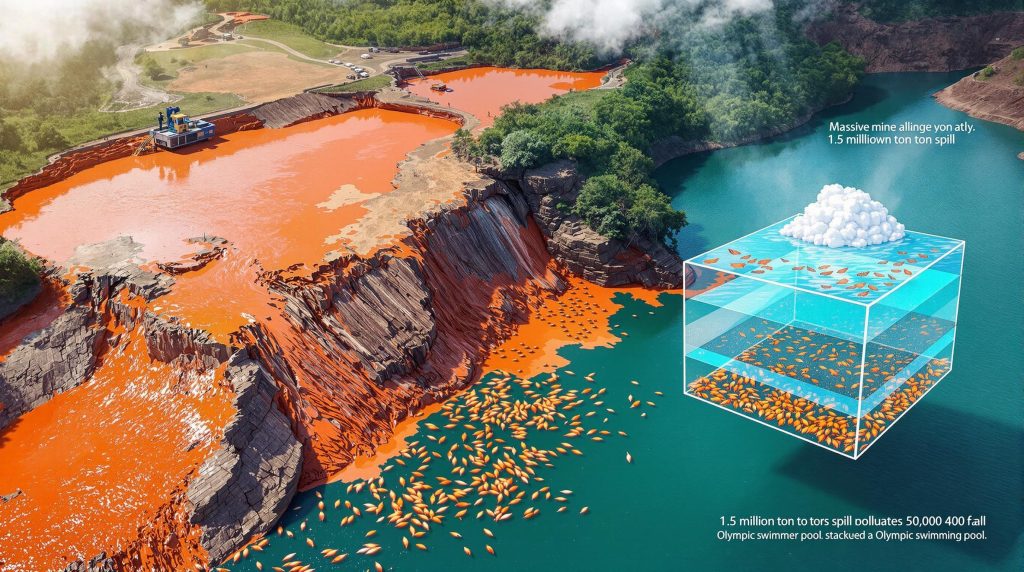Zambian Toxic Mine Spill: 30 Times Worse Than Reported
The environmental catastrophe unfolding in Zambia has shocked experts as independent assessments reveal a disaster far more severe than initially reported. What was first described as a manageable incident has emerged as one of the mining industry's worst environmental disasters, with far-reaching implications for local communities, the ecosystem, and Zambia's economic future.
What Happened at the Sino-Metals Leach Zambia Mine?
The Scale of the Disaster
An independent assessment by environmental risk mitigation firm Drizit Zambia Ltd. has revealed approximately 1.5 million tons of toxic sludge was released from the Sino-Metals Leach Zambia Ltd. mine near Kitwe in northern Zambia. This volume is equivalent to filling over 400 Olympic-sized swimming pools with hazardous material.
Most alarmingly, the actual spill volume is approximately 30 times larger than the original government and company estimates, which claimed only 50,000 tons had been released. This dramatic discrepancy has raised serious questions about transparency in reporting mining incidents.
Video evidence and field data collected by environmental experts directly contradict official accounts of the spill's magnitude, with Drizit describing the event as a "large-scale environmental catastrophe" that ranks among the mining industry's worst environmental concerns in mining disasters globally.
US Ambassador Michael Gonzales has gone further, calling it the "sixth-worst mining disaster in history" in an August 6 email to staff, underscoring the international recognition of the incident's severity.
How the Spill Occurred
The catastrophic release began with a dam wall breach following heavy rainfall on February 18, 2025. The failure of the waste reservoir at the copper processing facility released sulphuric acid-bearing material that is commonly used in copper extraction processes.
The structural integrity of the dam had reportedly been compromised by unusually heavy seasonal rains, though questions remain about whether proper maintenance and safety protocols were being followed prior to the failure.
As the dam wall gave way, millions of tons of toxic sludge flowed directly into the nearby Mwambashi River, creating an immediate environmental emergency that would affect waterways, farmland, and communities downstream.
What Environmental Impacts Has the Spill Caused?
Immediate Environmental Damage
The environmental consequences were swift and devastating. The toxic sludge flowed from the mine site directly into the Mwambashi River, with initial pH measurements showing acidity as low as 1—a level "strong enough to dissolve human bones," according to environmental experts cited in reports.
Collins Nzovu, Zambia's water and sanitation minister, confirmed these extreme acidity levels when addressing lawmakers on February 21, 2025, just days after the incident.
The highly acidic flow completely wiped out aquatic life for miles along waterways, devastating the local ecosystem. Adjacent farmland and crops were also contaminated, destroying livelihoods and food sources for local communities.
The contamination threat extends beyond the immediate area, as the Mwambashi River feeds into the Kafue River, which is a critical water source for larger populations, including the capital city Lusaka, threatening a much broader ecosystem collapse.
Long-Term Contamination Concerns
Beyond the immediate acidic damage, environmental assessments have detected the presence of heavy metals including arsenic, cyanide, and uranium in the contaminated water and soil. These elements present persistent environmental threats that will remain long after acid neutralization efforts are complete.
Approximately 800 individuals are still living in the fallout zone, facing ongoing exposure to these contaminants. This raises significant public health concerns, particularly regarding long-term exposure through drinking water, agricultural products, and fish consumption.
Drizit's assessment warned that "without immediate intervention, the consequences for future generations of Zambians will be severe and long-lasting," highlighting the potential for generational health impacts without proper remediation efforts.
The bioaccumulation of heavy metals in the food chain represents a particularly insidious threat, as contaminants can concentrate in fish and agricultural products, creating exposure pathways that extend far beyond the immediately affected area.
Emergency Response Measures
In response to the crisis, the Zambian government initiated the dumping of hundreds of tons of lime into affected rivers in an attempt to neutralize the highly acidic conditions. This emergency measure was aimed at mitigating the most immediate threats to aquatic life and water users.
Government officials have claimed success in restoring water quality through these neutralization efforts. To reassure residents, senior officials even appeared on state media drinking tap water from Kitwe to demonstrate its supposed safety.
Despite these public displays of confidence, independent assessments suggest contamination issues persist, particularly regarding heavy metals which are not addressed by acid neutralization measures.
To date, officials report no confirmed deaths or cases of heavy metal poisoning related to the toxic spill at China owned Zambian mine, though health monitoring systems may be insufficient to detect early signs of exposure-related illness.
Why Is This Spill Significant for Zambia?
Economic Implications
The disaster threatens President Hichilema's ambitious plan to more than triple Zambia's copper production to 3 million tons. As Africa's second-largest copper producer, Zambia's economic development strategy relies heavily on expanding its mining sector.
China Nonferrous Mining Corp., the parent company of Sino-Metals Leach Zambia, had pledged a $1.3 billion investment in 2023 to boost production. This incident raises questions about whether foreign investors will maintain their commitments amid environmental concerns and potential regulatory changes.
The mining sector is critical to Zambia's national economic development, providing employment, tax revenue, and export earnings. Any significant disruption or increased regulatory burden could impact growth projections and economic stability in a country already facing financial challenges.
Environmental remediation costs, which could potentially run into hundreds of millions of dollars, may further strain the relationship between the government and mining operators regarding who bears financial responsibility for the cleanup.
Diplomatic Complications
The spill has strained relations between Zambia and China at a particularly sensitive time. The Zambian government is currently working to restructure approximately $5.6 billion in Chinese debt, making diplomatic tensions particularly unwelcome.
The US Embassy's decision to order the evacuation of staff from Kitwe and surrounding areas signals international concern about the Zambian government's handling of the crisis and the accuracy of its public statements.
The incident has drawn unwanted international attention to mining governance accountability concerns in Zambia, potentially impacting future foreign investment in the mining sector as companies weigh reputational and regulatory risks.
How accountability is handled for this environmental disaster could influence broader economic and political relationships between Zambia and both Western nations and China, with implications for future development partnerships and financing arrangements.
How Have Authorities Responded to the Crisis?
Official Statements and Actions
The Zambian government has consistently downplayed concerns about the spill, stating there is "no cause for panic" and insisting that "water quality in the affected areas has been restored" following remediation efforts.
In a theatrical demonstration meant to reassure the public, senior officials appeared on state media drinking tap water from Kitwe to prove its safety, though questions remain about whether these gestures reflect genuine environmental conditions throughout the affected region.
Collins Nzovu, Zambia's water and sanitation minister, addressed lawmakers about the initial assessment on February 21, acknowledging the extreme acidity levels but emphasizing remediation efforts. Meanwhile, Mike Mposha, Zambia's green economy and environment minister, has "declined to immediately comment" on the scale of the disaster revealed by independent assessments.
The government maintains that "no deaths or confirmed cases of heavy metal poisoning have been reported," though independent health monitoring has been limited, and long-term health effects may not yet be apparent.
Disputed Assessment and Transparency Issues
Drizit Zambia Ltd., the environmental assessment company initially contracted to evaluate the spill, described its engagement with Sino-Metals as difficult from the outset, suggesting resistance to full transparency about the disaster's scope.
In a troubling development, Sino-Metals terminated its contract with Drizit, citing unspecified contractual breaches. This termination occurred just days before the conclusion of the environmental report, raising questions about whether the company was attempting to suppress unfavourable findings.
Drizit claimed that Sino-Metals attempted to disrupt the assessment process, impeding efforts to accurately determine the full environmental impact of the spill. The mining company has questioned Drizit's methodology for calculating the spill volume, disputing the 1.5 million ton figure.
These transparency issues have fueled concerns about whether findings are being prevented from reaching proper authorities and the public, hampering effective response and accountability.
What Are the Health Risks to Local Communities?
Exposure Pathways and Vulnerabilities
The most immediate concern is contamination of drinking water sources in communities along the Mwambashi and Kafue Rivers. With the Kafue River supplying water to Lusaka, the capital's water supply faces potential risk if contamination isn't properly contained.
Heavy metals present in the toxic sludge—including arsenic, cyanide, and uranium—can bioaccumulate in fish and agricultural products, creating multiple exposure pathways that extend far beyond direct water consumption.
The approximately 800 individuals still living near the contamination zone face particular risk of ongoing exposure through water, soil, air, and food. Children, pregnant women, and the elderly are especially vulnerable to the health effects of heavy metal exposure.
Without proper remediation, these contaminants can persist in the environment for decades, creating long-term exposure scenarios that may result in chronic health conditions among affected populations.
Public Health Response
The government has made repeated assertions that water quality has been restored to safe levels, directly contradicting the assessment from independent evaluators who warn of persistent contamination.
The US Embassy's warning about the continued presence of toxic substances suggests international authorities do not share the Zambian government's confidence in the effectiveness of remediation efforts thus far.
A comprehensive health surveillance program for affected communities would be necessary to identify and address exposure-related health issues, but reports suggest such monitoring systems are not yet adequately in place.
Without proper remediation and health monitoring, affected communities may face generational health impacts, including potential developmental issues in children, reproductive health problems, and increased cancer risks associated with heavy metal exposure.
How Does This Compare to Other Mining Disasters?
Historical Context of Major Mining Spills
The US Embassy's assessment ranking this as the sixth-worst mining disaster in history places it among a notorious group of environmental catastrophes that have caused lasting damage worldwide.
While specific comparisons to other major tailings dam failures haven't been detailed in reports, the 1.5 million ton volume makes this significantly larger than many well-documented mining disasters of the past decade.
The pattern of initially underreporting the scale of mining industry accidents appears consistent with historical precedents, where initial company and government estimates often minimize the true extent of environmental damage.
The toxic spill at China owned Zambian mine raises important questions about whether global mining safety standards and regulations are sufficient to prevent similar disasters, particularly in regions with less robust environmental oversight.
Lessons from Previous Environmental Catastrophes
Recovery timelines from similar-scale disasters suggest that complete ecosystem restoration could take decades, with some environmental impacts potentially being permanent without extraordinary intervention.
Effective remediation approaches from past disasters typically involve a combination of immediate containment, neutralization of harmful chemicals, removal of contaminated materials, and long-term monitoring and restoration efforts.
The financial implications for cleanup operations in comparable cases have often run into hundreds of millions of dollars, raising questions about whether Sino-Metals and its parent company will commit adequate resources to comprehensive remediation.
Previous mining disasters have led to enhanced corporate accountability mechanisms and regulatory reforms in many jurisdictions, suggesting the Zambian case could potentially catalyze improved environmental governance in the country's mining sector.
What Are the Next Steps for Remediation?
Required Environmental Cleanup Measures
A comprehensive remediation plan would need to include the removal of toxic substances from affected waterways and soil, going well beyond the initial acid neutralization efforts using lime.
Long-term monitoring of water quality in the Mwambashi and Kafue Rivers will be essential to track recovery and identify any persistent contamination issues that require additional intervention.
Soil remediation in contaminated agricultural land presents a particular challenge, as heavy metals can bind to soil particles and persist for decades without proper treatment or removal.
Protection of the broader Kafue River ecosystem and Kafue National Park will require ongoing vigilance and potentially expanded remediation efforts if contamination is found to have spread further downstream than initially assessed.
The timeline for environmental recovery will depend on the comprehensiveness of remediation efforts, with partial recovery of aquatic ecosystems potentially achievable within years under ideal circumstances, but complete restoration likely requiring decades.
Regulatory and Corporate Responsibility
Establishing clear accountability mechanisms for the mining operation will be crucial in ensuring adequate resources are committed to cleanup and compensation for affected communities.
Financial responsibility for the extensive remediation required will likely be a point of contention between the government and Sino-Metals, with potential implications for other mining operations in Zambia if new regulatory frameworks emerge from this crisis.
Independent verification of remediation progress by trusted third parties will be essential in rebuilding public confidence and ensuring cleanup efforts meet international standards.
The disaster may prompt regulatory reforms to prevent future incidents, potentially including stricter standards for tailings dam construction and maintenance, more rigorous environmental impact assessments, and enhanced monitoring requirements.
International standards in mine reclamation innovation and waste management, such as those developed following previous disasters, could provide a framework for improving practices across Zambia's mining sector if properly implemented and enforced.
FAQ: Zambian Mine Toxic Spill
How does this spill affect Zambia's copper production goals?
The disaster creates significant challenges for President Hichilema's ambitious plan to triple copper output to 3 million tons. Beyond the immediate production disruption at the affected facility, the incident raises serious questions about environmental oversight across Zambia's mining sector.
Increased regulatory scrutiny and potential new environmental requirements could slow expansion plans and increase operating costs for mining companies. Additionally, investor confidence may waver if the government's handling of the crisis is perceived as inadequate.
The $1.3 billion investment pledged by China Nonferrous Mining Corp. in 2023 may face reassessment in light of potential liability and remediation costs associated with the spill. Any pullback in foreign investment would significantly impact Zambia's production goals.
What health risks do local communities face from the contamination?
Communities face potential exposure to heavy metals including arsenic, cyanide, and uranium through contaminated water, soil, and the food chain. These substances can cause both acute and chronic health problems depending on exposure levels and duration.
While acute poisoning cases haven't been confirmed, long-term exposure risks remain significant for the approximately 800 individuals still living near the fallout zone. Chronic exposure to arsenic and uranium has been linked to increased cancer risks, while cyanide exposure can cause neurological damage.
Children are particularly vulnerable to developmental issues from heavy metal exposure, while pregnant women may face risks of pregnancy complications and potential impacts on fetal development. These health risks could persist for generations without proper remediation and health monitoring.
How is the Zambian government addressing the environmental damage?
The government has implemented emergency measures including dumping hundreds of tons of lime into affected rivers to neutralize acidity. Officials maintain that these efforts have successfully restored water quality, with senior officials publicly drinking tap water to demonstrate safety.
However, independent assessments suggest that while acid neutralization may have addressed the most immediate threat, persistent contamination from heavy metals requires more comprehensive remediation that has not yet been adequately implemented.
The government's public communications have focused on reassurance rather than transparency about the full scale of the disaster, raising questions about whether sufficient resources and expertise are being deployed to address long-term environmental impacts.
What impact might this have on Zambia-China relations?
The incident complicates diplomatic ties at a critical time when Zambia is working to restructure approximately $5.6 billion in Chinese debt. How accountability is handled for this environmental disaster could influence broader economic and political relationships between the nations.
If Zambian authorities pursue significant penalties or remediation requirements against the Chinese-owned mining company, it could create tensions that affect debt restructuring negotiations and future investment commitments.
Conversely, if the government is perceived as too lenient on a Chinese company responsible for major environmental damage, it could face domestic political backlash and international criticism, potentially complicating relationships with Western partners and financial institutions.
Further Resources on Mining Safety and Environmental Protection
Those interested in learning more about mining safety standards and environmental protection in the extractive industries can explore resources from international organizations specializing in sustainable mining practices.
Industry publications regularly track developments in mining environmental standards, providing context on how disasters like the Zambian spill compare to global best practices and regulatory frameworks.
Environmental remediation techniques for mining contamination continue to evolve, with new approaches offering potential for more effective cleanup of heavy metal contamination in soil and water systems affected by industrial spills.
Want to Spot the Next Major Mineral Discovery Before the Market?
Stay ahead of the curve with Discovery Alert's proprietary Discovery IQ model, providing instant notifications when significant mineral discoveries are announced on the ASX. Explore historic returns from major discoveries and understand how early identification translates to investment success by visiting our discoveries page.




